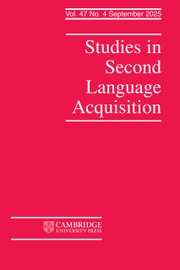Crossref Citations
This article has been cited by the following publications. This list is generated based on data provided by
Crossref.
Andringa, Sible
and
Curcic, Maja
2015.
HOW EXPLICIT KNOWLEDGE AFFECTS ONLINE L2 PROCESSING.
Studies in Second Language Acquisition,
Vol. 37,
Issue. 2,
p.
237.
Andringa, Sible
and
Rebuschat, Patrick
2015.
NEW DIRECTIONS IN THE STUDY OF IMPLICIT AND EXPLICIT LEARNING.
Studies in Second Language Acquisition,
Vol. 37,
Issue. 2,
p.
185.
Godfroid, Aline
and
Winke, Paula
2015.
Implicit and Explicit Learning of Languages.
Vol. 48,
Issue. ,
p.
325.
Godfroid, Aline
2016.
THE EFFECTS OF IMPLICIT INSTRUCTION ON IMPLICIT AND EXPLICIT KNOWLEDGE DEVELOPMENT.
Studies in Second Language Acquisition,
Vol. 38,
Issue. 2,
p.
177.
Loewen, Shawn
and
Plonsky, Luke
2016.
An A–Z of Applied Linguistics Research Methods.
p.
1.
Gutiérrez, Xavier
2016.
Analyzed knowledge, metalanguage, and second language proficiency.
System,
Vol. 60,
Issue. ,
p.
42.
Baleghizadeh, Sasan
and
Derakhshesh, Ali
2017.
Measuring the Effectiveness of Explicit and Implicit Instruction through Explicit and Implicit Measures.
Iranian Journal of Applied Linguistics,
Vol. 20,
Issue. 1,
p.
81.
Metzner, Paul
von der Malsburg, Titus
Vasishth, Shravan
and
Rösler, Frank
2017.
The Importance of Reading Naturally: Evidence From Combined Recordings of Eye Movements and Electric Brain Potentials.
Cognitive Science,
Vol. 41,
Issue. S6,
p.
1232.
Indrarathne, Bimali
and
Kormos, Judit
2017.
ATTENTIONAL PROCESSING OF INPUT IN EXPLICIT AND IMPLICIT CONDITIONS.
Studies in Second Language Acquisition,
Vol. 39,
Issue. 3,
p.
401.
SUZUKI, YUICHI
2017.
Validity of new measures of implicit knowledge: Distinguishing implicit knowledge from automatized explicit knowledge.
Applied Psycholinguistics,
Vol. 38,
Issue. 5,
p.
1229.
Suzuki, Yuichi
and
DeKeyser, Robert
2017.
The Interface of Explicit and Implicit Knowledge in a Second Language: Insights From Individual Differences in Cognitive Aptitudes.
Language Learning,
Vol. 67,
Issue. 4,
p.
747.
Gass, Susan
2018.
The Palgrave Handbook of Applied Linguistics Research Methodology.
p.
313.
Paquet, Pierre-Luc
2018.
Linear Distance: A Multi-Tiered Methodology in the Acquisition of Gender Agreement.
SSRN Electronic Journal ,
THOMAS, KAVITA E.
2018.
Comparing Explicit Exemplar‐Based and Rule‐Based Corrective Feedback: Introducing Analogy‐Based Corrective Feedback.
The Modern Language Journal,
Vol. 102,
Issue. 2,
p.
371.
Bextermöller, Delaram
2018.
Reading Latin and the need for empirical research: A psycholinguistic approach to reading comprehension in Latin.
Journal of Latin Linguistics,
Vol. 17,
Issue. 2,
p.
281.
GODFROID, ALINE
AHN, JIEUN
CHOI, INA
BALLARD, LAURA
CUI, YAQIONG
JOHNSTON, SUZANNE
LEE, SHINHYE
SARKAR, ABDHI
and
YOON, HYUNG-JO
2018.
Incidental vocabulary learning in a natural reading context: an eye-tracking study.
Bilingualism: Language and Cognition,
Vol. 21,
Issue. 3,
p.
563.
Schmidtke, Jens
2018.
PUPILLOMETRY IN LINGUISTIC RESEARCH.
Studies in Second Language Acquisition,
Vol. 40,
Issue. 3,
p.
529.
Shiu, Li-Ju
Yalçın, Şebnem
and
Spada, Nina
2018.
Exploring second language learners’ grammaticality judgment performance in relation to task design features.
System,
Vol. 72,
Issue. ,
p.
215.
Kachlicka, Magdalena
Saito, Kazuya
and
Tierney, Adam
2019.
Successful second language learning is tied to robust domain-general auditory processing and stable neural representation of sound.
Brain and Language,
Vol. 192,
Issue. ,
p.
15.
Zyzik, Eve C.
and
Sanchez, Ruben A.
2019.
Beyond accuracy: Heritage speakers’ performance on two kinds of acceptability judgment tasks.
Applied Psycholinguistics,
Vol. 40,
Issue. 03,
p.
645.

